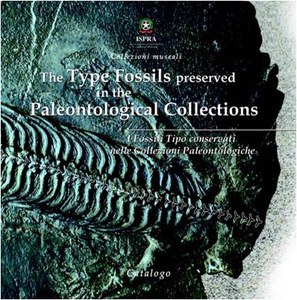The Type Fossils preserved in the Paleontological Collections
The type Fossils of the Paleontological Collections of the Geological Survey of Italy represent a scientific heritage of international significance, being reference specimens for the taxonomic attribution of the species. The first project of a catalog of "types" titled “Catalogue of types preserved in Paleontological Collections of APAT - Rome”, has been published in the Volume LXV of the “Memorie descrittive della Carta Geologica d’Italia” and presented during the 32° International Geological Congress, held in Florence in August 2004. The volume earned deep interest in the scientific community and the copies were quickly sold out.
This new Catalogue, in English and Italian with a new refined graphic style, aims to be not only a working tool for specialists, providing catalographic documents and scientific description of the Types. It is also a means of popularization of the Institute’s heritage and of all the activities aimed at the preservation, cataloguing, updating and disclosure of Collections, carried out over the last 150 years within the Paleontological Collections.
The 244 Type Fossils preserved and described in the catalogue all belong to the animal kingdom, to the groups Mollusca, Arthropoda, Echinodermata and Chordata (subphylum Vertebrata), distributed in six classes including Cephalopoda (25 specimens), Gastropoda (5 specimens), Trilobita (181 specimens), Echinodermata (26 specimens), Osteichthyes (3 specimens) and Reptilia (4 specimens). The most represented group then, is the one of Trilobites which constitute about 75 % of the total, specimens coming all from the Cambrian strata of south-western Sardinia, the oldest outcrops in Italy.
In the first part of the volume, the history of the Paleontological Collections belonged to the Geologic Survey of Italy, today preserved by the ISPRA, is widwly described and illustrated in a vast iconography, with particular reference to the prestigious thematic and historical Collections in which the type specimens are present. The projects of cataloguing and inventorying, management and web popularization of the finds are here exposed, both the projects already realized and those still in progress. The "types fossils” are also described following the order of phyla and classes, with particular reference to the studies carried out by the Authors who have established the species. The close connection between the specimens, the Authors who have sampled and studied them and the collections to which they belong are also been emphasized.
The second part of the book is the Catalogue in the strict sense in wich are listed the species in taxonomic and alphabetical order, complete of their key data, including the status, the place of origin and the original literature references, with the necessary references to plates where they are figured in this volume. A detailed bibliography of taxa, divided by taxonomic groups and separated from the general bibliography, provides the reader with a useful tool for specialized study.
The third part consists of 45 plates with color illustrations of all holotypes and lectotypes, as well as some paratypes and plesiotypes, pictures taken according to different rules; some reproductions of original drawings are also included. New plates with the figures of five specimens of Echinodermata has now been inserted.
The analytical indexes at the end of the volume complete the text, facilitating the research of the species, the species’ Authors and the specimen original localities throughout the Catalogue.

